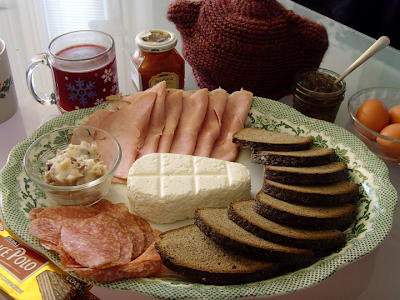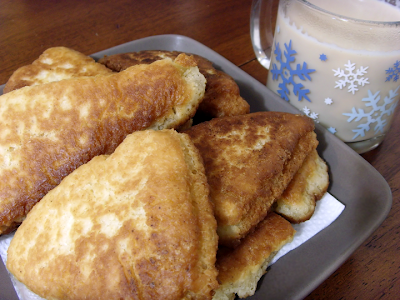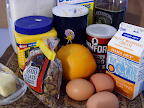Background
I was only able to find two dishes in my search for Algerian breakfast. The first meal I found was makrout, which is a fried cookie made with semolina flour and flavored with almonds or dates. This week was our first time taking the IBP on the road and we were unsure how our host was equipped deep frying, so we went in another direction. We settled on making chakchouka which consists of peppers and onions in a tomato sauce and then poaching eggs in the sauce. The chakchouka is then eaten with either a local flat bread or a baguette. The recipe we used was from a very comprehensive cookbook of vegetarian cuisine from the Mediterranean called Mediterranean Harvest. It has over 500 recipes and seems pretty well written from what I have read of it. We went with a purchased baguette for simplicity, and we substituted poblano peppers for the recommended anaheims because we could not find them.
Chakchouka
- 2 tbsp extra virgin olive oil
- 1 large onion, sliced thin
- 2 green peppers, sliced
- 2 red peppers, sliced
- 2 poblano peppers, diced
- 4 cloves of garlic, minced
- 2 tsp of harissa (we used more)
- 1 tsp tabil (recipe follows)
- 1 (28oz) can diced tomatoes, drained
- ¼ cup chopped parsley (optional)
- 4 eggs
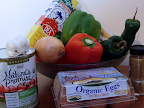
- Heat oil in pan and add the onions. Cook until golden, about 10 minutes.
- Add the peppers and cook until they are soft, about 5 minutes.
- Add the garlic and cook until fragrant (just a few seconds), then stir in harissa, tabil, and salt & pepper to taste.
- Add the tomatoes and cook until thickened.
- Add most of the parsley, reserving some to add with the eggs.
- Use a spoon a make 4 depressions into sauce, and crack an egg into each depression. Cover the pan with a lid or tin foil if a lid is not available.
- The eggs will poach in about 5 to 6 minutes and they should still have runny yolks.
- Flavor the eggs with harisa, tabil, parsley, and salt & pepper to taste.
- Eat with baguette or flatbread.
- 4 tbsp coriander seeds
- 1 tbsp caraway seeds
- 2 tsp garlic salt
- 2 tsp cayenne pepper
- Grind whole seeds using a spice mill.
- Mix this with the garlic salt and cayenne pepper and keep in a jar. (It makes enough to fit in an average spice jar.)
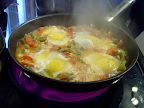 This meal was a big success. It comes out as a very flavorful and spicy tomato sauce with eggs in it. I added a couple more teaspoons of harissa to make it spicier and this was really nice. The baguette soaks up the juices really well and quickly takes on the chakchouka flavor. The cookbook mentions making the sauce a day or so before hand and adding the eggs before serving to let flavor mingle. I will use this as a pasta sauce in the future.
This meal was a big success. It comes out as a very flavorful and spicy tomato sauce with eggs in it. I added a couple more teaspoons of harissa to make it spicier and this was really nice. The baguette soaks up the juices really well and quickly takes on the chakchouka flavor. The cookbook mentions making the sauce a day or so before hand and adding the eggs before serving to let flavor mingle. I will use this as a pasta sauce in the future.

